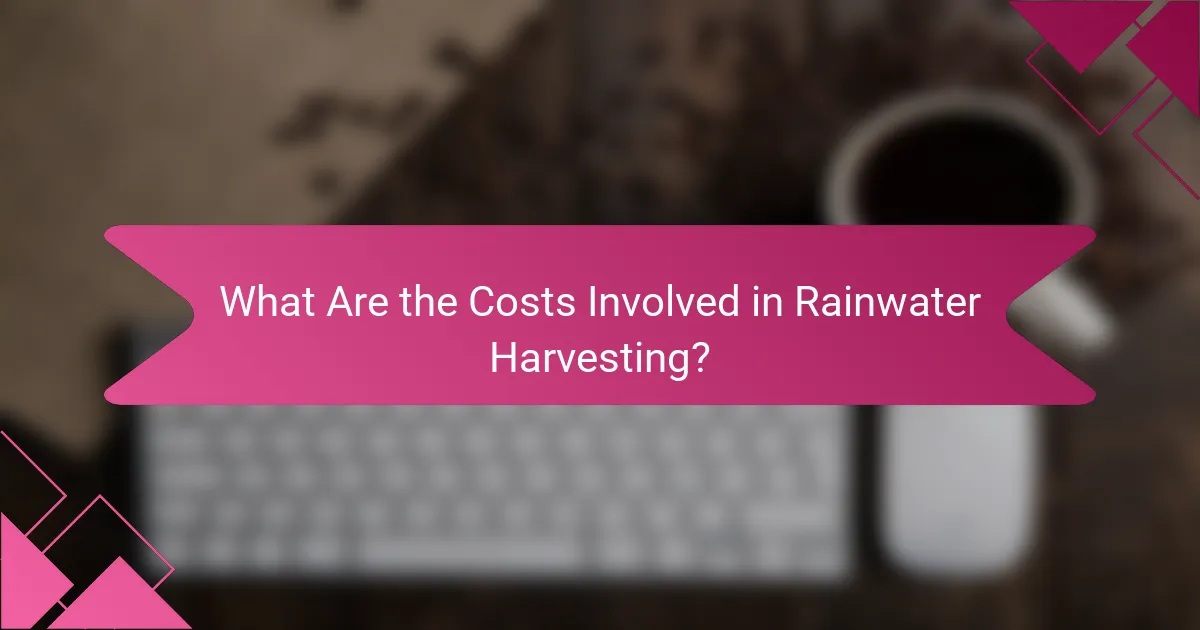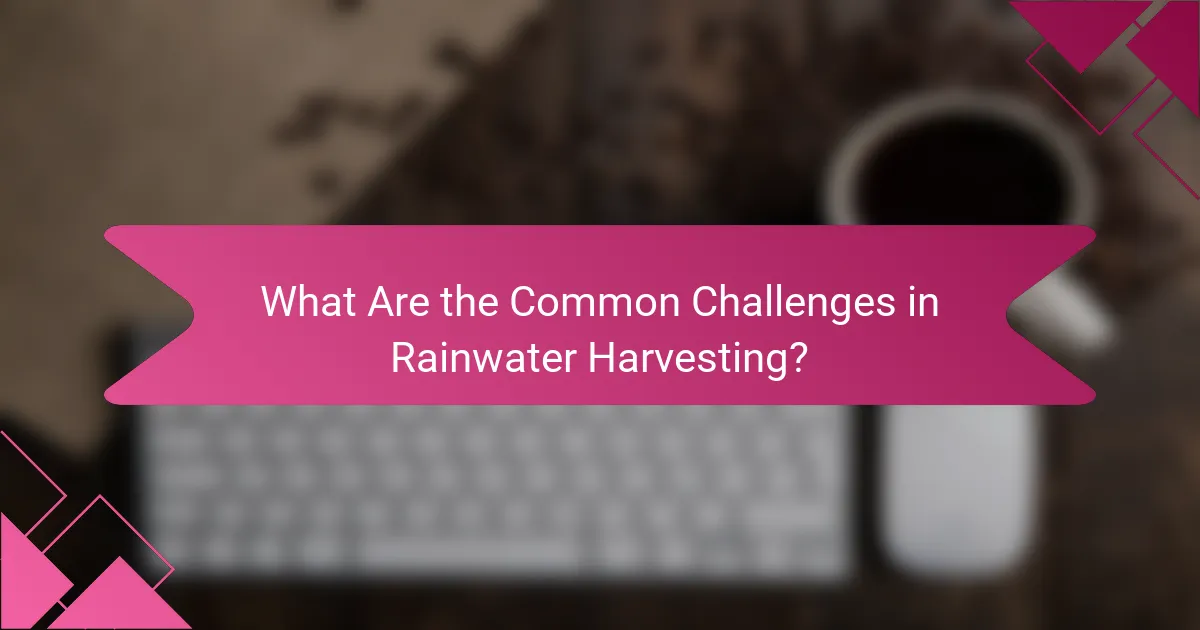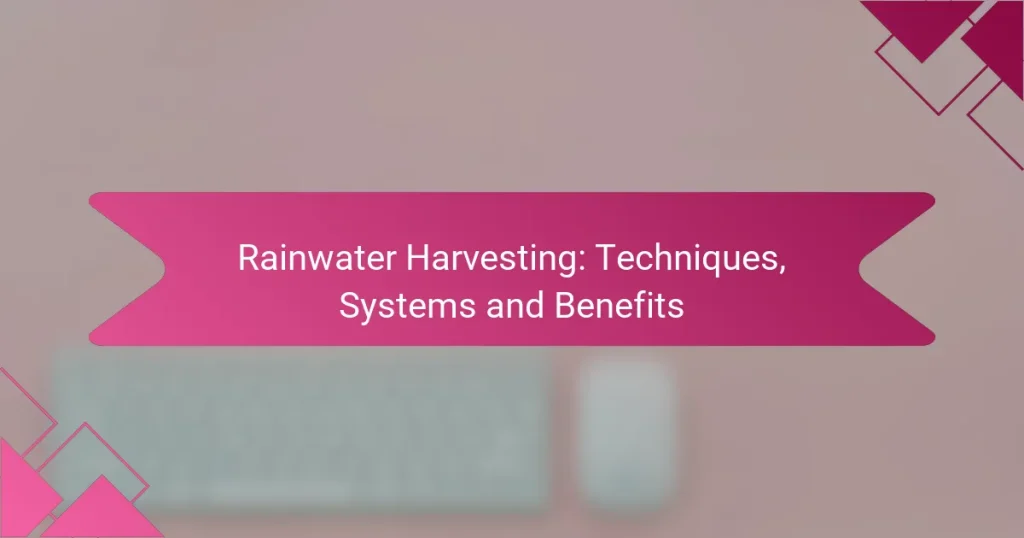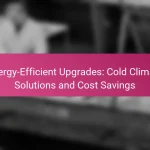Rainwater harvesting is an effective method for collecting and storing rainwater, providing a sustainable alternative to traditional water sources. By implementing various techniques and systems, individuals and communities can enjoy significant benefits, including cost savings and improved water quality, while reducing their reliance on municipal supplies. Understanding local regulations and assessing specific water needs are crucial steps in selecting the right system for effective rainwater utilization.

What Are the Main Techniques for Rainwater Harvesting?
The main techniques for rainwater harvesting include various systems designed to collect and store rainwater for later use. These methods vary in complexity and application, catering to different environments and needs.
Rooftop Collection Systems
Rooftop collection systems are among the most common methods for harvesting rainwater. They involve installing gutters and downspouts to direct rainwater from roofs into storage tanks. This technique is particularly effective in urban areas where building surfaces can capture significant amounts of rainfall.
When implementing a rooftop collection system, ensure that the roof materials are safe for water collection, avoiding toxic substances. Regular maintenance of gutters and filters is essential to keep the system functioning efficiently.
Surface Runoff Collection
Surface runoff collection captures rainwater that flows over land surfaces, directing it into storage systems. This method is often used in agricultural settings where runoff from fields can be channeled into ponds or cisterns for irrigation purposes.
To optimize surface runoff collection, design the landscape with gentle slopes and swales that guide water flow. Be mindful of potential contaminants from agricultural runoff, and consider using filtration systems to improve water quality.
Rain Gardens
Rain gardens are designed to absorb rainwater from impervious surfaces like driveways and sidewalks. These gardens consist of native plants and soil that filter and retain rainwater, reducing runoff and promoting groundwater recharge.
When creating a rain garden, select plants that thrive in wet conditions and require minimal maintenance. Position the garden in a naturally low area to maximize water absorption and consider the local climate to choose appropriate plant species.
Permeable Pavements
Permeable pavements allow rainwater to infiltrate through surfaces like driveways and parking lots, reducing runoff and promoting groundwater recharge. This technique is beneficial in urban areas where traditional asphalt or concrete can lead to flooding.
When installing permeable pavements, ensure proper subgrade preparation and maintenance to prevent clogging. Regular cleaning and occasional repairs may be necessary to maintain functionality.
Underground Storage Tanks
Underground storage tanks are used to store harvested rainwater for later use, such as irrigation or non-potable applications. These tanks can be made of various materials, including concrete or plastic, and are typically buried to save space.
When considering underground storage, ensure compliance with local regulations regarding installation and maintenance. Regular inspections are crucial to prevent contamination and ensure the system’s longevity.

What Are the Benefits of Rainwater Harvesting in the US?
Rainwater harvesting offers numerous benefits in the US, including cost savings, environmental advantages, and improved water quality. By capturing and utilizing rainwater, households and communities can reduce reliance on municipal water supplies and mitigate the impacts of stormwater runoff.
Cost Savings on Water Bills
Implementing a rainwater harvesting system can lead to significant savings on water bills. Homeowners can reduce their dependence on treated municipal water for non-potable uses like irrigation, toilet flushing, and laundry, which can account for a substantial portion of monthly water expenses.
For example, families may save anywhere from 20% to 50% on their water bills, depending on their usage and the size of the rainwater system. Investing in a rainwater collection system often pays for itself within a few years through these savings.
Reduction of Stormwater Runoff
Rainwater harvesting helps to reduce stormwater runoff, which can lead to flooding and water pollution. By capturing rainwater, systems decrease the volume of water that flows into storm drains and local waterways, mitigating erosion and protecting aquatic ecosystems.
In urban areas, where impervious surfaces dominate, rainwater harvesting can significantly lessen the burden on drainage systems during heavy rainfall. This proactive approach can help cities manage stormwater more effectively and reduce the risk of combined sewer overflows.
Improved Water Quality
Collecting rainwater can lead to improved water quality for various uses. Rainwater is typically free from the chemicals and contaminants found in municipal water supplies, making it a great option for irrigation and other non-potable applications.
However, it’s essential to maintain the collection system properly to ensure water quality. Regular cleaning of gutters and storage tanks, along with proper filtration, can help keep the harvested rainwater safe and clean for its intended uses.
Environmental Sustainability
Rainwater harvesting promotes environmental sustainability by conserving water resources and reducing the demand on local aquifers and water treatment facilities. This practice supports the responsible use of natural resources and encourages a more sustainable lifestyle.
Moreover, by decreasing stormwater runoff, rainwater harvesting helps protect local ecosystems and biodiversity. It contributes to the overall health of the environment, making it a beneficial practice for both individuals and communities.

How to Choose a Rainwater Harvesting System?
Choosing a rainwater harvesting system involves assessing local regulations, evaluating your water needs, and considering the appropriate system size. These factors ensure that your system is compliant, efficient, and tailored to your specific requirements.
Assessing Local Regulations
Before installing a rainwater harvesting system, check local regulations and guidelines, as they can vary significantly by region. Some areas may require permits, while others might have restrictions on the use of harvested rainwater for potable purposes.
Contact your local government or water authority to obtain information on any relevant laws. Understanding these regulations will help you avoid fines and ensure your system is legally compliant.
Evaluating Water Needs
Assess your household or business water needs to determine how much rainwater you should harvest. Consider factors such as the number of occupants, daily water consumption, and seasonal variations in rainfall.
A rough estimate is that a family of four might need around 300-400 liters of water per day. This information will guide you in selecting a system that meets your specific demands throughout the year.
Considering System Size
The size of your rainwater harvesting system should reflect both your water needs and the available catchment area, such as roof size. A larger roof can collect more rainwater, but it also requires a bigger storage tank to hold the water.
As a general rule, a 100 square meter roof can yield approximately 100,000 liters of water annually in regions with moderate rainfall. Ensure your system is balanced to avoid overflow or underutilization, and consider installing a first-flush diverter to improve water quality.

What Are the Costs Involved in Rainwater Harvesting?
The costs of rainwater harvesting can vary widely based on system design, installation, and ongoing maintenance. Understanding these expenses helps in making informed decisions about the investment in a rainwater collection system.
Initial Installation Costs
Initial installation costs for rainwater harvesting systems typically range from a few hundred to several thousand dollars, depending on the complexity and scale of the system. Basic systems may include simple rain barrels, while more advanced setups can involve large storage tanks and filtration systems.
Factors influencing installation costs include the size of the catchment area, the type of storage tanks, and local labor rates. For instance, a residential system may cost between 1,000 and 5,000 USD, while commercial installations can exceed 10,000 USD.
Maintenance Expenses
Maintenance expenses for rainwater harvesting systems are generally low but should not be overlooked. Regular upkeep includes cleaning gutters, inspecting tanks, and ensuring filters are functioning properly. Annual maintenance costs can range from 100 to 500 USD, depending on system size and complexity.
Homeowners should also consider potential repairs or replacements of components, which can add to long-term costs. It’s advisable to set aside a small budget each year for unexpected maintenance needs.
Long-term Savings
Investing in rainwater harvesting can lead to significant long-term savings on water bills, especially in areas with high water rates. By utilizing harvested rainwater for irrigation, toilet flushing, and other non-potable uses, households can reduce their reliance on municipal water supplies.
In many cases, homeowners can expect to save anywhere from 20% to 50% on their water bills after implementing a rainwater harvesting system. Additionally, some regions offer tax incentives or rebates, further enhancing the financial benefits of such systems.

What Are the Common Challenges in Rainwater Harvesting?
Common challenges in rainwater harvesting include space limitations and contamination risks, which can affect the efficiency and safety of the system. Addressing these issues is essential for successful implementation and maintenance of rainwater collection systems.
Space Limitations
Space limitations can significantly impact the design and effectiveness of rainwater harvesting systems. Homeowners and businesses must assess available areas for storage tanks and collection surfaces, as larger systems typically require more space. In urban settings, this can be particularly challenging, often necessitating creative solutions like vertical tanks or rooftop collection systems.
When planning a rainwater harvesting system, consider the size of the catchment area and the volume of water needed. A general guideline is to have at least 1 square meter of catchment area for every 100 liters of storage capacity. This helps ensure sufficient water collection during rainy periods.
Contamination Risks
Contamination risks are a critical concern in rainwater harvesting, as pollutants can compromise water quality. Rainwater can pick up debris, chemicals, and pathogens from rooftops and gutters, making proper filtration and treatment essential. Regular maintenance and cleaning of catchment surfaces can help mitigate these risks.
To reduce contamination, implement a first-flush system that diverts the initial runoff, which is likely to contain the highest levels of pollutants. Additionally, using food-grade storage tanks and ensuring proper sealing can further protect harvested water from contaminants. Regular testing for water quality is also recommended to ensure safety for intended uses.


